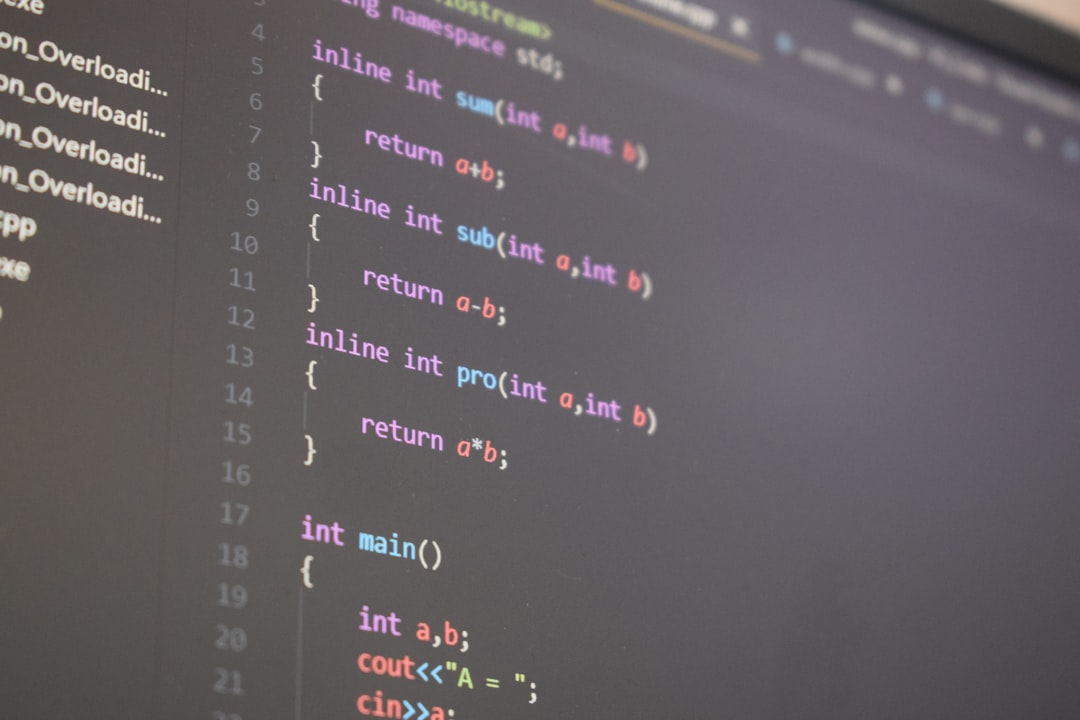Implementing Custom Stream Insertion Operators in C++ A Practical Guide
Implementing Custom Stream Insertion Operators in C++ A Practical Guide - Understanding Stream Insertion Operators in C++
In C++, the stream insertion operator (`<<`) is a key tool for managing output, particularly when dealing with custom data types. It streamlines the process of sending data to output streams like `std::cout`, simplifying the interaction with objects. The core of this power lies in operator overloading. By defining a custom insertion operator as a function, you can tailor how your objects are displayed. This function, always standalone, takes an output stream (`std::ostream`) as the first argument, providing a mechanism to control output format and behavior for your class. This ability to control how data is presented makes working with custom classes as straightforward as with standard types. C++ extends this further by enabling the operator to be generic, meaning it can be designed to handle multiple custom data types. This exemplifies the flexibility and power of C++'s input/output framework.
1. The stream insertion operator (`<<`), often called the "insertion operator," is a core component of C++'s I/O mechanism. It's not only instrumental for writing data to standard output streams like `std::cout` but also provides a pathway to extend its functionality for user-defined data types, which allows for a more adaptable and expressive way to represent data.
2. One notable feature of the insertion operator is its ability to be chained. This means multiple pieces of data can be printed in a single statement—for instance, `std::cout << obj1 << obj2;`—improving code clarity and overall efficiency.
3. When designing a custom insertion operator for a class, it's essential to follow the standard function signature: `std::ostream& operator<<(std::ostream& os, const MyClass& obj)`. The emphasis here is on returning the stream reference (`std::ostream&`) to facilitate chaining of further operations.
4. One benefit of customizing stream insertion is its contribution to more effective debugging. By controlling the way objects are printed, developers can easily inspect complex data structures during development, which can greatly aid in resolving issues.
5. While intuitive, improper overloading of the stream operator can introduce ambiguity or even runtime errors. Therefore, it's crucial to maintain a consistent approach to operator definition and usage across the codebase.
6. An interesting aspect of the stream insertion operator's design is that the left-hand operand always needs to be a stream object (such as `std::ostream`), while the right-hand operand can be a custom type. This reflects a key aspect of C++: the language's capability to be both highly performant and flexible in its usage.
7. Utilizing manipulators such as `std::endl` or `std::fixed` can complement the insertion operator's capabilities. This allows for formatted output without having to modify the overloaded operator itself, which promotes cleaner and more manageable code.
8. Stream insertion operators, in contrast to the stream extraction operators (`>>`), focus primarily on output operations. The extraction operators are designed for input, highlighting a clear distinction in their roles and implementation when dealing with custom data types.
9. A recurring challenge when implementing custom insertion operators is the lack of attention to spacing and formatting within the overloaded functions themselves. This can lead to cluttered and less informative output, diminishing the clarity of the presented data.
10. Implementing a custom stream insertion operator offers a way to expose the relationships within complex data structures. By providing a consistent and comprehensive representation of complex information, engineers gain the ability to communicate intricate data more clearly within their applications.
Implementing Custom Stream Insertion Operators in C++ A Practical Guide - Defining Custom Stream Insertion Operators for User-Defined Types
When working with user-defined types in C++, you often need a way to easily print their contents to the console or other output streams. This is where custom stream insertion operators come in handy. These operators, which overload the `<<` operator, are implemented as non-member functions that take an output stream (like `std::cout`) and your custom type as arguments. To provide a thorough representation of your type, it's common to grant the operator friend access to the class, enabling it to access private data. The operator returns the stream object, allowing for output chaining – a neat way to print multiple values in a single statement. However, remember that the way you format the output within the operator can significantly impact the readability of the resulting text. Avoiding unnecessary clutter or poorly-organized displays can greatly improve debugging efforts and communication of your data's meaning. In essence, custom stream insertion operators bridge the gap between the general-purpose I/O tools and your unique data structures, enhancing usability and debug efficiency.
1. Defining custom stream insertion operators bridges the gap between user-defined types and the standard C++ I/O framework, making our own data types feel like native parts of the language. This makes interacting with our custom objects as easy as interacting with built-in ones, promoting a more unified coding experience.
2. Consistency in how we implement custom stream insertion operators across a codebase boosts maintainability. If a team agrees on a consistent formatting style, changes to how data is displayed can be made in a single spot, simplifying adjustments and fostering better collaboration.
3. Friend functions are often the key to simplifying custom operator implementation, especially when we need access to private or protected data members. This approach enhances data hiding principles while still allowing us to directly influence how our objects are presented when streamed to output.
4. Automated testing can greatly benefit from custom stream insertion operators. Well-defined output allows us to easily check results against expectations, which is extremely helpful when it comes to regression testing and ensuring the quality of our code.
5. C++'s operator overloading isn't just for simple types; it can also be applied to more complex ones, like smart pointers. This lets us manage resources effectively while simultaneously maintaining readability in our output, improving the overall clarity of our code.
6. While we often focus on the practical use of stream insertion, the act of implementing them can also highlight the complexities of operator precedence in C++. It reminds us that creating robust and reliable custom operators requires meticulous attention to detail.
7. Custom insertion operators can be the foundation for building string-based serialization methods for network communication. Here, the visual representation of the data becomes vital for debugging network protocols or data formats, adding a whole new layer to the operator's role.
8. Not every class benefits equally from custom stream insertion operators. Lightweight data types, for instance, might not see much gain in terms of readability from these operators. This points to the need for a more critical evaluation of the necessity of custom stream insertion operators on a case-by-case basis.
9. Understanding the behavior of operator chaining is key, as C++ uses left-to-right associativity when evaluating these operations. If we miss this detail, it can lead to unexpected outcomes in more intricate statements.
10. While custom stream insertion operators are undeniably beneficial, their implementation requires careful consideration. Poorly designed output can lead to misinterpretations and confusion, undermining the very clarity they are meant to achieve. We must be mindful that clear output enhances code, but unclear output is ultimately counterproductive.
Implementing Custom Stream Insertion Operators in C++ A Practical Guide - Syntax and Structure of Overloaded Stream Insertion Operators
Overloading the stream insertion operator (`<<`) in C++ is essential for seamlessly integrating user-defined types into the standard input/output mechanisms. To achieve this, we create a function that takes an `ostream` object (by reference) and a constant reference to the object of our custom class. Returning an `ostream` reference (by reference) from this operator function is crucial, as it allows for the chaining of output operations, letting us write things like `std::cout << obj1 << obj2;` which can improve the readability of our code. The implementation can be either as a non-member function or as a friend function, the latter being useful when the need arises to access private class data. However, it's also worth noting that proper formatting of the output within this operator is important. A cluttered or poorly formatted output can make it hard to understand the data being shown. Implementing this functionality correctly doesn't only provide the required functionality, but it also improves the maintainability and overall usability of C++ programs, emphasizing the significance of these details in the broader context of program design.
1. When crafting custom stream insertion operators, we can leverage them to support design patterns like Visitor or Command, making interactions between complex classes and output streams more intuitive. This approach not only enhances the design's clarity but also adds flexibility to our code.
2. The choice of `std::ostream&` as the return type isn't just for chaining; it's a common practice in C++. This convention highlights how consistent operator design can subtly influence the coherence of a codebase.
3. One detail to keep in mind is that overloaded stream insertion operators can sometimes lead to implicit type conversions. If not carefully managed, this could lead to output that isn't what we expect. This behavior serves as a reminder of the potential downsides of type safety in operator overloading.
4. Unlike many other languages, C++ allows us to overload operators using non-member functions, helping us prevent namespace pollution and maintain encapsulation. This feature contributes to better-designed interfaces and ultimately cleaner code.
5. It's easy to get carried away with custom stream insertion operators. While they are excellent for making output more readable with complex data types, overdoing it with trivial types can lead to unnecessary code and potentially decrease performance. We need to be thoughtful about when they provide real value.
6. Stream insertion operators can be incorporated into a larger logging framework, making output redirection simple. This capability changes how we gather debugging information, offering an efficient way to track system states and data changes while running our program.
7. There are recommendations regarding how to implement custom stream insertion operators, such as returning the object to a constant state after outputting data. This helps maintain the object's integrity while keeping the operator's functionality robust.
8. Overloaded operators can express things in a way that regular functions can't, making the output of custom types feel more natural and less wordy. This further stresses the need for a balanced implementation to avoid distorting the presented data.
9. Interestingly, many C++ libraries and frameworks rely heavily on well-defined stream insertion operators for serialization and deserialization. This showcases their vital role in software architecture, going beyond straightforward output to more complex operations.
10. While there are typical ways to format output in stream insertion operators, individual coding styles often introduce significant variation. Recognizing this aspect can lead to inconsistencies among different developers, highlighting the importance of collaboration on output conventions.
Implementing Custom Stream Insertion Operators in C++ A Practical Guide - Accessing Private Members and Using the Friend Keyword
When crafting custom stream insertion operators, you often encounter the need to access the private members of a class to generate the desired output. This access, however, is typically restricted by the principles of encapsulation. The `friend` keyword offers a solution by granting specific functions or entire classes permission to bypass this restriction and interact directly with private and protected data members. This access becomes particularly critical when overloading operators like the stream insertion operator (`<<`). By designating the operator as a friend function, you can tailor the output format and behavior by directly manipulating the private members of the class whose data is being displayed. This approach is a valuable tool for producing well-defined output while still upholding data encapsulation. However, it's crucial to exercise restraint when employing the `friend` keyword. Overusing friend functions can lead to a breakdown of encapsulation boundaries, potentially making the class harder to maintain and understand in the long run. Finding a balance between providing necessary access and preserving data integrity is key when leveraging the `friend` keyword within your custom stream insertion operators. This careful consideration is fundamental to building clean, maintainable, and robust C++ code.
### Accessing Private Members and Using the Friend Keyword
1. The `friend` keyword in C++ is a tool that lets a function or another class peek into the normally hidden private and protected parts of a class. This is quite useful when building custom operators, such as our stream insertion operators, as it gives us direct access to the information we need for output formatting without breaking the principles of encapsulation.
2. By marking our stream insertion operator as a friend function, we maintain a balance: the class's data remains hidden (encapsulated), yet the operator still gets the access it needs. This careful approach often leads to cleaner and easier-to-maintain code because we only expose the absolute minimum necessary.
3. When dealing with friend functions, it's important to remember that this special access isn't inherited. If a parent class declares a function as a friend, its children don't automatically gain that same privilege. This is a key detail to remember as we build our class hierarchies.
4. Friend functions can have implications for how easily we can test our code. While they make access simpler, over-relying on them can lead to code that's too tightly coupled. It's worth asking whether a function truly requires access to private data, or if a slight redesign could provide a better interface for the needed interaction.
5. Overusing the `friend` keyword can cause unexpected problems during maintenance. If we lean too heavily on friend functions, the carefully guarded private data starts to lose its value, and the code becomes harder to follow.
6. Having multiple friend functions within a single class can create complex dependencies between them. This requires detailed documentation and careful planning to ensure the web of friendship relationships doesn't become a source of confusion.
7. While friend functions offer great flexibility in our designs, it's crucial to use them wisely. Exposing too much data can create security weaknesses and make debugging more challenging. We need to find the right balance between making data accessible and protecting it.
8. One interesting thing about friend functions is that they enable us to write operators in a way that's quite concise and expressive. Although this is very clear once we understand it, it can increase the cognitive load, especially for developers new to a codebase.
9. When we use friend functions for custom stream operators, it can potentially impact performance. For small data types, the difference might be negligible, but with larger structures, there can be additional overhead. It's something to consider and potentially profile in performance-critical applications.
10. Using friend functions for our custom stream operators creates a smooth path for data to flow from the hidden parts of a class to the public output. This allows us to build user-friendly interfaces that work seamlessly with C++'s I/O system. However, we must always remain cautious and be mindful of maintaining the integrity of our class designs while we utilize this tool.
Implementing Custom Stream Insertion Operators in C++ A Practical Guide - Implementing Chaining Support for Stream Insertion
Enabling chained stream insertions in C++ hinges on returning a reference to the output stream (`std::ostream&`) within your custom insertion operator. This design pattern allows you to string together multiple insertions in a single line, such as `std::cout << obj1 << obj2;`, promoting a more readable and efficient code style. Sometimes, declaring your overloaded operator as a friend function offers advantages by allowing it to access the class's private members for crafting more specific output formats. While this provides flexibility, it's essential to balance it against the goal of protecting your class's internal state through encapsulation. Paying attention to the overall structure and formatting of the output within the operator significantly impacts the way your custom data types are presented, contributing to more user-friendly and understandable C++ programs. Striking a balance between these aspects can lead to more effective and cleaner code.
1. Enabling chaining within custom stream insertion operators enhances code clarity by allowing for multiple outputs within a single statement, improving readability and possibly reducing the chances of making mistakes when outputting object data.
2. Unlike some languages, C++ allows for chaining output operations through non-member functions, which promotes a clear separation between responsibilities and lets the operator function be independent of the inner workings of the classes it interacts with, while still seamlessly handling our custom types.
3. A subtle but crucial aspect of chaining in C++ is the requirement for the inserted object to return the stream reference. Failing to do this can lead to broken chains, which may not be easy to spot during debugging.
4. Chaining isn't simply a nice way to write code—it can offer performance advantages by reducing the frequency of accessing the output stream. This can be quite helpful when dealing with frequent logging in applications that require real-time updates.
5. The power of chaining stream insertions can also lead to unexpected behavior if the overloaded operator isn't designed carefully to handle various types. This can introduce hard-to-find problems, particularly when dealing with implicit type conversions.
6. While chaining appears simple, things can get complex when dealing with user-defined types that themselves contain complex structures. This underscores the need to think carefully about the design of the operator function.
7. Creating a facade to chain stream insertions can simplify debugging by offering a straightforward trail of outputs, but this comes with a risk of potentially obscuring critical intermediate results that may be essential when troubleshooting intricate data processing.
8. A common mistake is to overlook that chained stream insertions are evaluated from left to right. If the state of objects changes within chained operations, neglecting this order can result in unexpected logic errors.
9. Exception handling is crucial when implementing chaining within custom stream insertion operators. If an error occurs in one part of the chain, it can disrupt the whole output process. Our operator implementations need to be robust to errors and handle them gracefully.
10. Interestingly, stream insertion chaining encourages a coding style that involves fluent interfaces. This style leads to clear and easy-to-follow interactions, contributing to a more refined approach to design within C++.
Implementing Custom Stream Insertion Operators in C++ A Practical Guide - Formatting Output with Stream Manipulators in Custom Operators
Within the context of custom stream insertion operators, "Formatting Output with Stream Manipulators in Custom Operators" delves into how we can refine the way our custom data types are displayed. This is achieved by employing C++ stream manipulators, which offer a flexible approach to formatting output beyond the basic capabilities of the insertion operator itself.
We can create our own manipulators to define specific formatting behaviors, allowing for a high degree of control when handling complex data structures. These manipulators can even influence the state of the output stream, enabling changes to subsequent outputs within the same stream. The ability to combine these custom manipulators with standard ones, like `std::endl` or `std::fixed`, provides a versatile and clean way to format output without cluttering the insertion operator itself.
This combined approach offers developers a powerful toolset for shaping output that aligns with specific requirements, whether for improved readability or adhering to professional presentation conventions. It's a practical technique for writing clearer and more maintainable code while keeping the internal structure of our classes well-protected through encapsulation.
1. The capacity to return a reference to `std::ostream` from a custom stream insertion operator (`<<`) is fundamental for enabling chaining, which lets you string together multiple objects' outputs in a single statement. This not only makes your code more readable but can also potentially lead to better performance because you can avoid repeatedly accessing the stream.
2. Unlike how regular functions work, chaining in C++ follows a left-to-right evaluation order, meaning it's crucial to consider the order of operations in your expressions. Otherwise, things can get messy, particularly if you're manipulating the state of objects within the chain.
3. Adding manipulators like `std::setw` and `std::setprecision`, or even creating your own custom manipulators, is a powerful way to influence how data is presented. You can include detailed formatting within your operators without needing to alter the basic functions of the operator themselves.
4. You can sometimes benefit from declaring the stream insertion operator as a friend function to enforce encapsulation. Doing so allows the operator to access a class's private members, leading to a cleaner interface while still hiding the data, a key practice in object-oriented programming.
5. It's important to avoid overloading the operator with excessive formatting. This can make your output difficult to understand and make it harder to troubleshoot problems in your code. Clear output is ultimately a debugging tool, and overly-complex output defeats this purpose.
6. The inherent flexibility of C++ allows custom stream insertion operators to be a valuable component when dealing with serialization. Serialization involves turning complicated objects into text formats so that they can be stored or transported, and your stream insertion operators can help provide that structural output.
7. A pitfall with stream insertion operators is that they can inadvertently lead to implicit type conversions. If you're not careful, you might find that your output isn't quite what you expected, because the compiler has implicitly converted a variable to a different type, so pay attention to operator design.
8. While chaining is a convenience, be wary of side effects within the operator functions. If you're modifying the state of objects within a chain of insertion operations, debugging can become tricky as you might not see the expected intermediate results.
9. The common practice of using custom stream insertion operators in library designs shows how integral they are to software design. They help to create APIs that are easy to understand and use because they control the output, creating a good experience for the library user.
10. When creating stream insertion operators, it's a delicate balancing act between providing access (through friend functions, for instance) and preserving encapsulation principles. If you go overboard with direct access, you can wind up with a system that's tightly coupled, which makes it difficult to maintain and understand.
More Posts from aitutorialmaker.com:
- →CSS Tricks Implementing Alternating Styles with nth-child(even) for Enhanced List Readability
- →Optimizing Insertion Sort Enhancing Performance for Small to Medium-Sized Datasets in AI Applications
- →Mastering the Arctangent Function in C A Practical Guide to atan() and atan2()
- →Optimizing Python Package Imports The Strategic Role of __init__py in Enterprise AI Projects
- →How Google's Enterprise AI Strategy Leverages Chrome Browser Data to Enhance Corporate Search Solutions
- →Optimizing SQL Queries Efficient Techniques for Finding Maximum Values Across Multiple Columns





